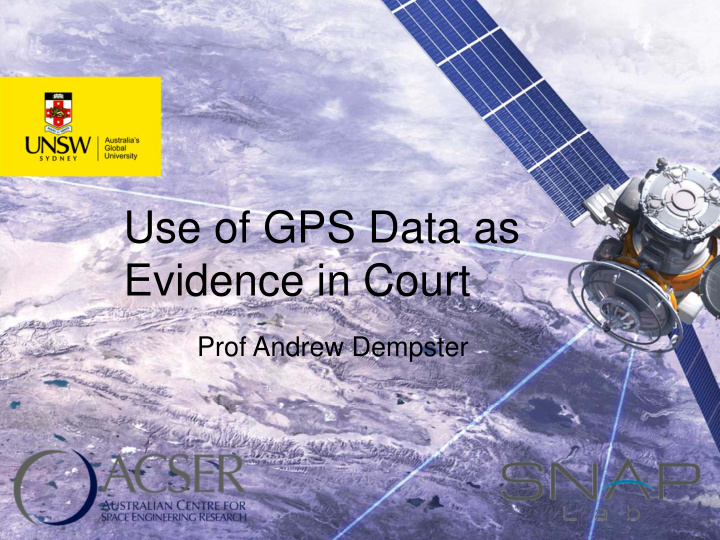



Use of GPS Data as Evidence in Court Prof Andrew Dempster
Legal Concerns • Early days: liability – “Space Law treaties cannot solve liability questions about the failure of a GNSS signal” – ICAO has tried to create a treaty re GNSS liabilty: not yet – Galileo used SA as a lever – (ubiquity liable when GNSS not used..) 2 IGNSS 2018, UNSW, Sydney
Legal Concerns • Privacy • Admissibility • Vulnerability • “Gathering” of evidence 3 IGNSS 2018, UNSW, Sydney
Legal Concerns • Specifically to do with GPS “errors”: – Police forcing entry to the wrong home – Repossession of wrong house – Demolition of wrong house • Recent study (83 cases) – 19 criminal/ 11 civil classifications – weight given to GNSS data “high” (8%) or “medium” (54%) – Significant majority “admissible” K J Berman, W B Glisson & L M Glisson, “Investigating the Impact of Global Positioning System Evidence”, 48th Hawaii International Conference on System Sciences, pp5234 ‐ 5243, 2015 4 IGNSS 2018, UNSW, Sydney
Our Issue: Quality • “the prosecution service needs to examine the GPS evidence thoroughly and must present other supporting evidence for GPS evidence to be admissible evidence in court” Ishwar Khadka, “The accuracy of location services and the potential impact on the admissibility of GPS based evidence in court cases”, BSc(Hons) thesis, University of Derby, 2015 5 IGNSS 2018, UNSW, Sydney
Where Do Erroneous Positions Come From? 6 IGNSS 2018, UNSW, Sydney
Receiver Mitigation • The receiver can report: – Weak signals (CNo) – Dilution of precision (DOP) (could also be calculated if actual satellite set is reported) – Multipath detection – Integrity information. Using e.g. RAIM to define protection limits – Spoofing detection. • Detection of doctored corrections and tampered logs not dealt with here (some standard methods for digital forensics) 7 IGNSS 2018, UNSW, Sydney
NMEA Messages: Common • GGA: time, lat, long, fix quality (GPS, DGPS, PPS, RTK, RTK float, dead- reckoned, manual, or simulated), no. satellites, HDOP, altitude, height of Geoid • GSA: 3D fix, satellites, PDOP, HDOP, VDOP. • GSV: satellites, elevation, azimuth, signal to noise (SNR) 8 IGNSS 2018, UNSW, Sydney
NMEA Messages: More Useful • GRS (Range residuals): time, residuals for each satellite. • GST (Pseudorange noise statistics): time, RMS value of residuals, error ellipse semi- major axis, semi-minor axis, orientation, lat 1 sigma, long 1 sigma, height 1 sigma 9 IGNSS 2018, UNSW, Sydney
Any Other Formats Provide Quality Info? • GPX: none • Android phones: provide raw range measurements • Aircraft “black box” has no requirement for quality – even position! • ADS-B has accuracy and integrity (protection limits) • AIS has position and whether RAIM guarantees 10m accuracy 10 IGNSS 2018, UNSW, Sydney
Case Study 1: Mona Vale Road • The Queen v Shane Anthony Day, 2014/00075246, NSW District Court • The question: was the vehicle speeding? 11 IGNSS 2018, UNSW, Sydney
12 IGNSS 2018, UNSW, Sydney
13 IGNSS 2018, UNSW, Sydney
14 IGNSS 2018, UNSW, Sydney
15 IGNSS 2018, UNSW, Sydney
Case Study 2: Moree • The Queen v Ian Robert Turnbull, 2014/00223920, NSW Supreme Court. • Question: is the GPS accurate? 16 IGNSS 2018, UNSW, Sydney
17 IGNSS 2018, UNSW, Sydney
18 IGNSS 2018, UNSW, Sydney
Future Work • Is this a fruitful area of research? • Raised more questions than it answered • Future work: – How to present GNSS evidence to meet quality of evidence. – Value of different logged data re quality of evidence. – A comprehensive study standardised and non- standardised logging – A proposal for a standardised logging method that includes integrity etc – A proposal for a standardised integrity 19 IGNSS 2018, UNSW, Sydney
Recommend
More recommend